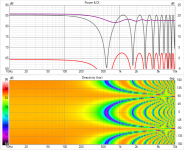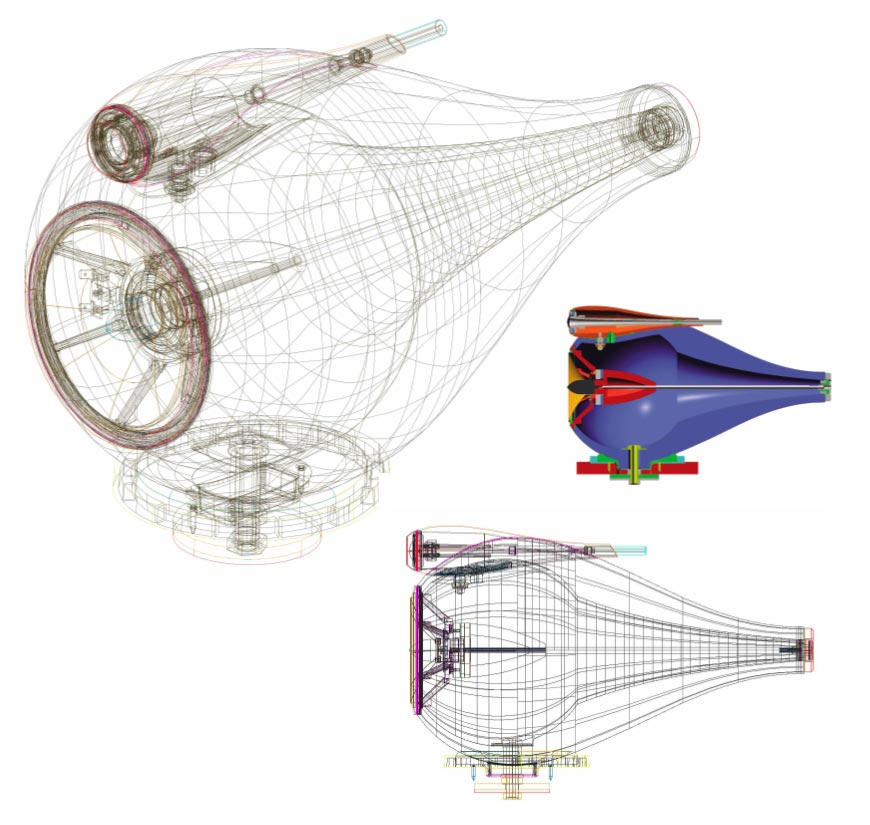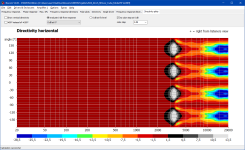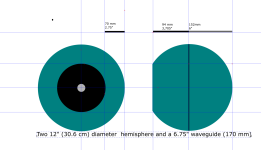I don't see it that way, direction wasn't mentioned. Also the electronic version takes acoustics out of the equation.Toole: "The effect is audibly obvious if it occurs in an electronic signal path or if there is a single, strong reflection ... "
My interpretation: the delayed sound and original sound come from the same direction is audible.
Taking a look at the acoustics of two simple displaced sources, the power varies differently to the response at one angle, causing DI to be affected.
This means EQ won't be effective, and the reflections will have a unique timbre.

I found it too simple of a "test".
https://www.intechopen.com/chapters/45612
View attachment 1258030
So much of what is sensitive is defined by our ear shape and head shape.
The 2 mics don't account for this. (search HRTF for more)
I'd say the test is perfectly viable. If we listen with one ear or two, HRTF will influence what we hear in both cases.
The difference between one mic and two, the two spaced like an averaged sized head does demonstrate that there is a difference between Stereo perception and measuring with one mic. Specifically for phantom center sounds. It simply demonstrates a comb filter occurrence that is present when listening to a stereo setup. There are many more comb patterns we perceive, the minute we place a speaker in a room.
While @olsond3 questioned the use of multiple drivers, a single driver with it's mirror images in ground floor, ceiling and walls has a similar effect.
In fact, his speaker that does have multiple sources will help hide some of that combing because each separate source will have slightly different reflection patterns before it reaches the listener's ear. Together they will average out the stronger single reflections you'd get from a single source speaker. If you look at the in-room results in a simulation from Vituixcad with floor, ceiling and wall reflections active one should be able to see these differences.
An array of drivers can do similar things, though a straight array will only do it in one plane (floor and ceiling).
Here's an example of the frequency result of an array vs a single speaker at the listening spot with floor and ceiling reflections active:
The louder result (watch the orange in-room prediction) is the (frequency filtered) Array, which one suffers from more comb filtering?
Sometimes things are not what we would think they are. One would think all those separate sources would perform worse, right?
The single source suffers from more comb filtering because of the in-room floor and ceiling reflections. The floor and ceiling settings are exactly the same, the (reduced) comb pattern from the array due to C to C spacing of the drivers is still visible, but what effect is worse when listening to both?
I'd like to see in-room predictions from the sphere source too, as it will probably be superior to a single driver result. If it is, it would be because of it's multiple sources at slightly differing distances and positions.
wesayso: Nice work. I should look at making a model of the sphere in Vituixcad. I am new to that program and find that following the required manual steps in the right sequence along with the folder and file name requirement are a bit cumbersome. Vituixcad worked great for the open baffle speaker I modeled.
For anyone interested I attached a project file modeling the sphere for Visaton Boxsim. Once the project is built, it's a single click to re-run the whole analysis. I modeled it as a cube in Boxsim, as that is all that is available, but that should be fairly representative of the sphere as it has the same number of drivers located in the same orientation in space as the sphere. The distance around the cube is longer, so the model shows slightly lower frequencies of the interference between drivers than I see in my measurements of the sphere. I used the ideal Thiel Small model so the baffle and phase difference effects are not obscured by ripples in the driver response. The Boxsim model is great because you can see the response from any direction from the cube (sphere) and see exactly how it repeats.
If the multiple drivers are co-located around a single cabinet so as to produce acoustic delays between the drivers sound as it is projected in any direction it is difficult to escape the frequency response variations. The room reflections serve to provide the listener more information about the location of the source of the sound and are really independent of the performance of the speaker.
Below are the measured directivity of the sphere as built and the prediction from the attached Boxsim model for a cube of the same size.

Figure 1: Measured Directivity of 4" sphere with six 2" drivers.

Figure 2: Boxsim calculated directivity of 4" cube with a 2" driver on each of six faces.
For anyone interested I attached a project file modeling the sphere for Visaton Boxsim. Once the project is built, it's a single click to re-run the whole analysis. I modeled it as a cube in Boxsim, as that is all that is available, but that should be fairly representative of the sphere as it has the same number of drivers located in the same orientation in space as the sphere. The distance around the cube is longer, so the model shows slightly lower frequencies of the interference between drivers than I see in my measurements of the sphere. I used the ideal Thiel Small model so the baffle and phase difference effects are not obscured by ripples in the driver response. The Boxsim model is great because you can see the response from any direction from the cube (sphere) and see exactly how it repeats.
If the multiple drivers are co-located around a single cabinet so as to produce acoustic delays between the drivers sound as it is projected in any direction it is difficult to escape the frequency response variations. The room reflections serve to provide the listener more information about the location of the source of the sound and are really independent of the performance of the speaker.
Below are the measured directivity of the sphere as built and the prediction from the attached Boxsim model for a cube of the same size.
Figure 1: Measured Directivity of 4" sphere with six 2" drivers.
Figure 2: Boxsim calculated directivity of 4" cube with a 2" driver on each of six faces.
Attachments
Do you audition these with the listener blindfolded? Reducing expectations in advance...Hi Alan,
That's some marketing material that they claim supports the design choices for the speaker they build. I see that Axiom Audio makes a large tower speaker they claim to be omni-directional while it obviously cannot be a uniform full range omni-directional source given the widely varying directivity pattern produced by vertically stacked tweeters and midranges, drivers spaced far apart on the cabinet and no drivers on the sides, top or bottom surfaces.
I think it is important to differentiate between between a comb filtering effect measured at one microphone location produced by multiple speaker boxes, each with even directivity and flat frequency response, distributed in a room verses a single speaker with wild variations in frequency response and directivity up and down the scale due to driver spacing and crossover choices for that one box. I think you could imagine that it would be possible to construct the same frequency response at a single microphone with both scenarios, but the listening experience would be very different when listening to a stereo pair.
While trying different crossovers with a friend on his large 3-way tower speakers we discovered an interesting audible effect. With a three way first order crossover, the single speaker produced a small localized sound stage that gave the impression that this single three way speaker was a large source of sound. This was an entertaining almost synthetic localized "stereo" effect from the one speaker due to the large overlap in the response of the three drivers at the two crossover points. Using presets on a digital crossover, were were able to rapidly switch between different completed crossover designs with a remote control. Each crossover produced a measured flat on axis response. With a higher order crossover, such that there was very narrow overlap of the drivers, the sound from one speaker collapsed down to what sounded like a smaller not quite point source. This is good, but not entertaining, hence the invention of stereo recordings. With a high order crossover the vertical lobes in the directivity are much reduced. So in this case the lobes in the directivity and variation in frequency response at different angles were produced by a single multi-driver speaker due to it's first order crossover, but this is a fixed effect with nothing to do with the recording, the room, or speaker placement. So it produces confusing location cues when combine with room acoustics and recorded venue information. I think many manufacturers such as Axiom, Definitive Tech, Wilson Audio, every multi-driver dipole speaker with low order crossovers and others with drivers scattered around the speaker and / or first order crossovers leverage this sort effect to make an entertaining speaker with a large source presence from each single speaker.
All that to say I think that speakers with uneven directivity and frequency response muddy the water for extracting the information from the recording and producing a performance that sounds like it is happening in your room. With the relatively smooth directivity and frequency response I've achieved with the spheres, see post #466, the results have been very unique and the imaging in the room is perceived to be quite precise. Due to
people being very polite it is often difficult to get critical comments from people that listen to my speakers. Often you just get nothing if they are bad.
In the four occasions I have demonstrated the spheres, the first pair sold in five minutes into the listening session, the second pair was praised by the
owner of a recording studio while playing his personal recordings and I was continuously congratulated on the sound by person after person at the meeting with 40 or so attendees last week. So my anecdotal evidence indicates the even response has some merit.
Dana
Do you audition these with the listener blindfolded? Reducing expectations in advance…
That is a valid point. No blindfolds, but that may happen this summer. The PNW Audio Society holds the only blinded evaluation speaker contest that I'm aware of in the USA every two years in the Seattle area. The speakers are evaluated on sound alone, no mid-west beauty contests here. A small panel of qualified judges with an acoustically transparent screen wall between them and the speakers.
Two friends that came out to hear them in my listening room told me that initially they really didn't expect much. That's not surprising when you see them in context next to the other speakers in my room. The spheres are tiny, dwarfed even by the Blueroom Minipods, and the woofer is the smallest one in the room. I'm sure people seeing the Axiom Bipolar speakers for the first time expect and are rewarded with a lot of sound and high SPL capability from those large tall towers packed with drivers on both sides.
Unlike large towers, I think the market appeal for a bug eyed ball at the end of a spindly stick may be somewhat limited.
Last edited by a moderator:
I've heard about the PNW contest that seems very cool. What's the older looking console under the turntable?
Cheers. Perception of a mic, not a head. (mad props for the vcad sim though)The difference between one mic and two, the two spaced like an averaged sized head does demonstrate that there is a difference between Stereo perception and measuring with one mic.
Spaced like a head is not the same as the changes caused by the head shape and the ears. That was my point. The head can make some sounds more forward, some have a head shadow, and some are not effected by the head at all.
What's the older looking console under the turntable?
That is the Barzilay 762 speaker my father purchase around 1968. He grew up on a farm and was able to build anything he wanted. So when he couldn't find the equipment cabinet shown in the picture below, he just built a copy himself from scratch.
Attachments
I think Barzilay built several configurations including empty. This pair had the JBL LE 12C installed. I recall that dad thought they had the separate woofer and horn tweeter when he bought them used and was disappointed when he opened them up. The 12C had very muted and rolled off high end, and sort of billowing bass with the tuning in this box. I fitted some drivers from Madisound in the late 1980's to make them a three way. I opened them up last month and plan to retune the port, install a modern midrange and design and a well engineered three way crossover so they can be listened to with out cringe.
Hi,
I am choosing drivers for a spherical speaker, dual sphere, tweeter and woofer and I was considering the Satori TW29BNWG-4 Beryllium Dome Tweeter with Waveguide. My only concern is the interaction if the waveguide and the sphere. The sphere will have a radius of 3.5", about 80mm. Is this a good way to go, or another tweeter without a wave guide would be a better option? tks,

I am choosing drivers for a spherical speaker, dual sphere, tweeter and woofer and I was considering the Satori TW29BNWG-4 Beryllium Dome Tweeter with Waveguide. My only concern is the interaction if the waveguide and the sphere. The sphere will have a radius of 3.5", about 80mm. Is this a good way to go, or another tweeter without a wave guide would be a better option? tks,
If you put a 6.5" waveguide on to a 7" sphere, it will be like a rear cap. You'll quickly round the edges of the waveguide back around to it. However, it is that edge section that is the most important part of the rollback.
If I were in your situation I'd continue the waveguide design thoughtfully around to 180 degrees (going backward, ie normal to the sides), and then put a hemisphere on to it.
If I were in your situation I'd continue the waveguide design thoughtfully around to 180 degrees (going backward, ie normal to the sides), and then put a hemisphere on to it.
the 7" diameter was an starting idea, it can be made larger. If i understand you correctly, get two 10" hemispheres, (9-12" maybe) and cut one at the level to mount the 6.5" and join the other together, thus having about 1.5 inch "border" around the speaker. Is this what you meant?

That does not look like it is near big enuff. You want the curve of the waveguide to meet the curve of the sphere in a fairly gentle continuous curve.
And then ou would need to sculpt out the bottom so that it nestles as close as possile to the midBass.
dave
And then ou would need to sculpt out the bottom so that it nestles as close as possile to the midBass.
dave
DaveSpheres are typically either made with found items (like the blanda bowls), other semi-sperical forms. Or use of something round as a base to create a fiberglass/composite creation (sort of like you are making a pair of bowls (can it come out of the mold any other way. this also points to big chunck of wood and a lather or high-z CNC.
Translam is a laour intensive method with high materials cost.
Ready made sphers can be bought as well.
A sphere has the worst possible internal resonance signature, one needs to at least have significant damping at the centre. If you are going the way of doinf anything but repurposing something already Spherical (like bowls) i would suggest taking it a step further and follow the R&D that created these:

dave
I described the ways to create cabs like this in another post. Carlson Hulls is super easy software to model and cut foam or ply to make these shapes without using translam. Its a panel system with a bunch of long narrow ply panels forced into shape over a frame that forms the brace. Like ply boat sides
Your task will to be to make a functional region between 90 degrees and 180 degrees. I've shown that here in red. Your work will determine the diameter of the hemisphere (blue), not the other way around. I want to make it clear that I've done no calculations to demonstrate the red portion is practically functional, but it does represent an example of a smooth transition.Is this what you meant?
Its called a fair curve and the software that I mentioned uses that principal to create a structural shape
It's not a fair curve per se, there is more to it than that. As I mentioned, it determines the diameter, not the other way around.. unless you're constrained for space 😉Its called a fair curve
This shape cannot came from a hemisphere mold, I would need foam foam or 3d print shaped in a way similar to the image and then make a mold or apply the fiber glass in top of it (that is how we made hemispheres before, by making a mold out of a plexiglass hemisphere). It looks that I may have to forgo those tweeters and look for another option.

Attachments
- Home
- Loudspeakers
- Multi-Way
- How to build a spherical speaker?

